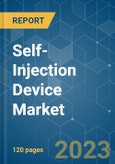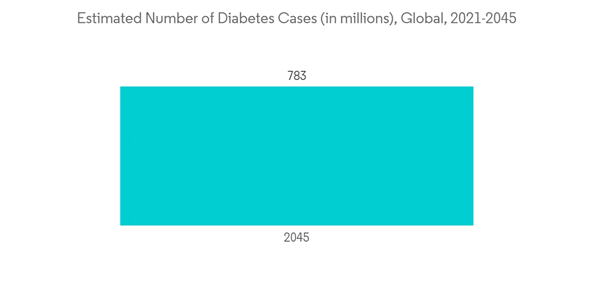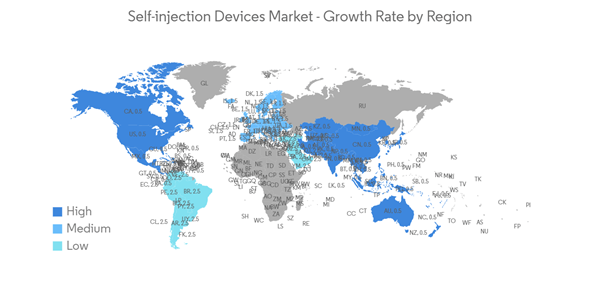The COVID-19 pandemic had an impact on the self-injection devices market as the requirement for self-injectable devices and mass vaccination witnessed a rise since the outbreak of the disease. The threat of getting exposed to COVID-19 had urged patients, particularly those suffering from chronic ailments to opt for self-administration of medication such as self-injection devices at home for easy use. Healthcare professionals kept the healthcare properties free for COVID-19 victims and patients with a need for acute care. This generated the demand for self-injection devices such as wearable injectors. Significantly, the COVID-19 vaccines will increase the demand for injectable devices and the pandemic has also shown the benefit of self-use devices as well as connected devices. Post-pandemic there may be a rise in upcoming innovation in devices and pharma manufacturers will progressively collaborate to use self-injection devices in combination with other digital assets such as apps, phones, and personal computers. Eventually, this will bring the patient into far greater control of their care.
The major factors boosting the growth of the self-injection devices market are the growing prevalence of chronic diseases and the benefits that lead to a rise in demand for self-injection.
Self-injection devices allow patients with chronic diseases to gain control of their treatment schedule and their treatment setting, thus allowing greater independence and freedom in their social, domestic, and professional lives. Self-injection may also offer psychological benefits over administration by healthcare professionals, including improved self-esteem. Removing the need to attend a clinic or hospital for regular injections also brings economic benefits to both the patient and the healthcare system. This economic benefit has been the major growth-driving factor for this market.
Major chronic diseases such as cancer, cardiovascular diseases, chronic lung disease, stroke, Alzheimer’s, diabetes, and chronic kidney disease are on the rise all over the world, has also helped the growth as self-injections have applications in recovery from these illnesses. Cancer is a leading cause of death all around the world, accounting for around 10 million deaths in 2020. According to the GLOBOCAN 2020 report, the total number of people in the world affected by cancer in 2020 accounts for around 19,292,789 cases. The number is estimated to rise to 28,887,940 cases by 2040. The increasing prevalence of chronic diseases is expected to add to the market growth, owing to the increase in drug delivery applications.
The recent product launches by major key market players are also adding to the growth of the studied market. For instance, in September 2022, Owen Mumford Pharmaceutical Services launched its new Aidaptus auto-injector platform that has a patient-centric design with automatic needle insertion that provides a simple and consistent user experience. Moreover, in October 2021, Ypsomed introduced the world’s first autoinjector with integrated connectivity. It connects the SmartPilot, a networked reusable attachment to the YpsoMate autoinjector for incorporating the auto-injector into a digital therapy management system.Such activities are likely to add to the growth of the market over the forecast period.
However, stringent regulations for approval from regulatory authorities and a lack of awareness of such devices in developing and underdeveloped economies have been restraining the growth of this market.
Self-Injection Device Market Trends
Pen Injectors are Expected to Cover a Larger Market Share over the Forecast Period
Pen injectors are used for the subcutaneous delivery of biopharmaceuticals. Although they are also administered by professionals, they are primarily used for self-administration by the patient. First developed to replace vials and syringes for the treatment of diabetes with insulin, such injection devices have been an important part of drug-delivery devices for a long time.According to the International Diabetes Federation Diabetes Atlas Tenth edition 2021, in 2021, around 537 million adults all over the world were found to have diabetes; with the numbers projected to grow to 643 million by 2030 and 783 million by 2045. Moreover, diabetes prevalence has been rising more rapidly in middle- and low-income countries. Hence, the worldwide increase in the number of diabetes cases causes an increase in the use of patient self-injection devices, which helps in the easier self-administration of insulin rather than visiting a hospital for the everyday dose. Thus, the studied market segment is expected to grow further in the future.
Owing to the rising cases of diabetes in recent years, there have been several product launches focused on pen injectors, that help diabetic patients administer their daily dose of insulin efficiently. For instance, in November 2021, Innovation Zed, novel diabetes management technologies developer launched the InsulCheck DOSE technology which will enter the market in 2022. Thus, product approval by the key players is increasing the adoption of pen injectors, which is expected to boost the growth of the market segment over the forecast period.
Thus, the segment is expected to witness significant growth over the forecast period due to the abovementioned factors.
North America is Expected to Dominate the Market over the Forecast Period
The North American region is expected to hold a major share of the market. The increasing prevalence of chronic diseases in the region is a major factor contributing to the market growth over the forecast period.According to the American Cancer Society’s 2022 report, over 1.9 million new cancer are expected to be recorded in the United States in 2022. Also, as per the same source, the risk of having cancer rises dramatically as one gets older, and in the United States, 80% of cancer patients are 55 or older, with 57% being 65 or older. Thus, the growing geriatric population is expected to have a significant positive impact on the growth of the studied market. Further, according to the International Diabetes Federation’s report of December 2021, about 32.2 million people were living with diabetes in the United States in 2021, and this number is estimated to increase to 36.3 million by 2045, and this increase in the diabetes patient pool is expected to drive demand for injectables which will boost growth in the injectable drug delivery devices market in the United States.
With the growing demand for effective therapeutics for chronic diseases, the company activities such as product launches, mergers and acquisitions, partnerships, and strategic collaborations are expected to augment growth in the studied market in the country. For instance, in December 2021, NuGen Medical Devices received approval from Health Canada for its needle-free injection system and accessories, also known as InsuJet. Such activities boost the market growth over the forecast period.
Self-Injection Device Competitor Analysis
The self-injection device market is moderately competitive with several major players. The majority of the key player involved in the research and manufacturing of self-injection devices are established in developed countries. Major players in the market studied are Becton, Dickinson and Company, Insulet Corporation, Ypsomed AG, Gerresheimer AG, Halozyme (Antares Pharma Inc), and others.Additional benefits of purchasing the report:
- The market estimate (ME) sheet in Excel format
- 3 months of analyst support
This product will be delivered within 2 business days.
Table of Contents
Companies Mentioned (Partial List)
A selection of companies mentioned in this report includes, but is not limited to:
- Becton, Dickinson and Company
- Gerresheimer AG
- Insulet Corporation
- Ypsomed AG
- Halozyme (Antares Pharma Inc)
- West Pharmaceutical Services
- Recipharm AB
- Owen Mumford Ltd.
- SHL Group Auto










